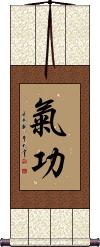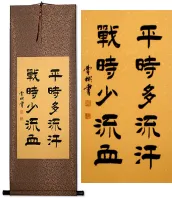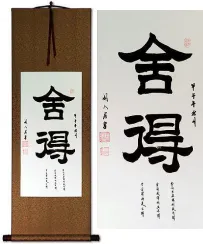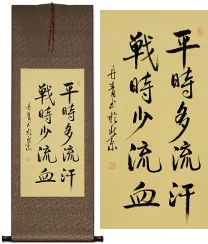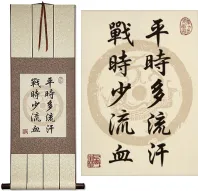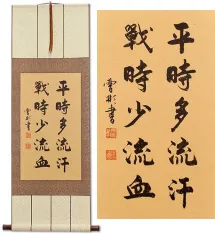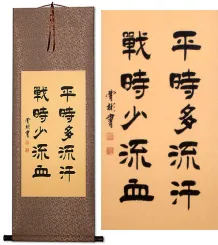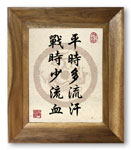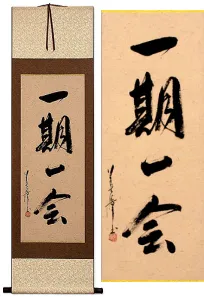Many custom options...
And formats...

Not what you want?
Try other similar-meaning words, fewer words, or just one word.
Feel free to email me with your request. If it's easy, I'll translate it for free and add it to this database of calligraphy for you.
Go One More in Chinese / Japanese...
Buy a Go One More calligraphy wall scroll here!
Qi Gong / Chi Kung
氣功 or Qigong is the title of a technique that is somewhere between medical practice, meditation, and in some cases, religion.
The definition is blurred depending on which school of Qigong you are following. In some cases, it is even incorporated with martial arts.
Some people (even Chinese people) mix this title with Tai Chi (Tai Qi) exercises.
Lately, in China, people will claim to practice Tai Chi rather than Qigong because the Qigong title was recently used as a cover for an illegal pseudo-religious movement in China with the initials F.G. or F.D. (I can not write those names here for fear of our website being banned in China).
You can learn those names and more here: Further info about Qigong
If you are wondering why I wrote “Qi Gong” and “Chi Kung” as the title of this calligraphy entry, I should teach you a little about the various ways in which Chinese can be Romanized. One form writes this as “Chi Kung” or “Chikung” (Taiwan). In the mainland and elsewhere, it is Romanized as “Qi Gong” or “Qigong.” The pronunciation is the same in Taiwan, mainland, and Singapore Mandarin. Neither Romanization is exactly like English. If you want to know how to say this with English rules, it would be something like “Chee Gong” (but the “gong” has a vowel sound like the “O” in “go”).
Romanization is a really confusing topic and has caused many Chinese words to be mispronounced in the west. One example is “Kung Pao Chicken,” which should actually be more like “Gong Bao” with the “O” sounding like “oh” for both characters. Neither the Romanization system in Taiwan nor the Mainland is perfect, in my opinion, and leads to many misunderstandings.
In modern Japan, you may see this written as 気功, but the original 氣功 is still recognized. If you need the Japanese version, please contact me.
This in-stock artwork might be what you are looking for, and ships right away...
Gallery Price: $72.00
Your Price: $39.88
Gallery Price: $220.00
Your Price: $99.88
Gallery Price: $200.00
Your Price: $69.88
Gallery Price: $120.00
Your Price: $61.88
Gallery Price: $120.00
Your Price: $61.88
Gallery Price: $90.00
Your Price: $49.88
Gallery Price: $220.00
Your Price: $112.88
Gallery Price: $220.00
Your Price: $99.88
Starting at: $19.88
Gallery Price: $60.00
Your Price: $36.88
Gallery Price: $60.00
Your Price: $36.88
Gallery Price: $60.00
Your Price: $36.88
Gallery Price: $340.00
Your Price: $188.77
Not the results for go one more that you were looking for?
Below are some entries from our dictionary that may match your go one more search...
| Characters If shown, 2nd row is Simp. Chinese |
Pronunciation Romanization |
Simple Dictionary Definition |
一來 一来 see styles |
yī lái yi1 lai2 i lai ichirai |
firstly, ... (一來向) sakṛdāgāmin. Only one more return to mortality, v. 斯 and 四向. |
一間 一间 see styles |
yī jiān yi1 jian1 i chien hitoma ひとま |
one room; (surname) Ichima ekavīcika 翳迦鼻致迦 Still one final stage of mortality before nirvāṇa. Also wrongly styled bījaka 鼻致迦, a seed 一種 which leads to one more reincarnation. |
今一 see styles |
imaichi いまいち |
(adj-na,adv) (1) (kana only) (colloquialism) (See 今一つ・いまひとつ・1) one more; another; the other; (2) (See 今一つ・いまひとつ・2) not quite; not very good; lacking; (surname) Imaichi |
再度 see styles |
zài dù zai4 du4 tsai tu saido さいど |
once more; once again; one more time (adv,n) a second time; again; once more; twice |
十地 see styles |
shí dì shi2 di4 shih ti juuji / juji じゅうじ |
{Buddh} dasabhumi (forty-first to fiftieth stages in the development of a bodhisattva); (place-name) Jūji daśabhūmi; v. 十住. The "ten stages" in the fifty-two sections of the development of a bodhisattva into a Buddha. After completing the十四向 he proceeds to the 十地. There are several groups. I. The ten stages common to the Three Vehicles 三乘 are: (1) 乾慧地 dry wisdom stage, i. e. unfertilized by Buddha-truth, worldly wisdom; (2) 性地 the embryo-stage of the nature of Buddha-truth, the 四善根; (3) 八人地 (八忍地), the stage of the eight patient endurances; (4) 見地 of freedom from wrong views; (5) 薄地 of freedom from the first six of the nine delusions in practice; (6) 離欲地 of freedom from the remaining three; (7) 巳辨地 complete discrimination in regard to wrong views and thoughts, the stage of an arhat; (8) 辟支佛地 pratyeka-buddhahood, only the dead ashes of the past left to sift; (9) 菩薩地 bodhisattvahood; (10) 佛地 Buddhahood. v. 智度論 78. II. 大乘菩薩十地 The ten stages of Mahāyāna bodhisattva development are: (1) 歡喜地 Pramuditā, joy at having overcome the former difficulties and now entering on the path to Buddhahood; (2) 離垢地 Vimalā, freedom from all possible defilement, the stage of purity; (3) 發光地 Prabhākarī, stage of further enlightenment; (4) 焰慧地 Arciṣmatī, of glowing wisdom; (5) 極難勝地 Sudurjayā, mastery of utmost or final difficulties; (6) 現前地 Abhimukhī, the open way of wisdom above definitions of impurity and purity; (7) 遠行地 Dūraṁgamā, proceeding afar, getting above ideas of self in order to save others; (8) 不動地 Acalā, attainment of calm unperturbedness; (9) 善慧地 Sādhumatī, of the finest discriminatory wisdom, knowing where and how to save, and possessed of the 十力 ten powers; (10) 法雲地 Dharmamegha, attaining to the fertilizing powers of the law-cloud. Each of the ten stages is connected with each of the ten pāramitās, v. 波. Each of the 四乘 or four vehicles has a division of ten. III. The 聲聞乘十地 ten Śrāvaka stages are: (1) 受三歸地 initiation as a disciple by receiving the three refuges, in the Buddha, Dharma, and Saṅgha; (2) 信地 belief, or the faith-root; (3) 信法地 belief in the four truths; (4) 内凡夫地 ordinary disciples who observe the 五停心觀, etc.; (5) 學信戒 those who pursue the 三學 three studies; (6) 八人忍地 the stage of 見道 seeing the true Way; (7) 須陀洹地 śrota-āpanna, now definitely in the stream and assured of nirvāṇa; (8) 斯陀含地 sakrdāgāmin, only one more rebirth; (9) 阿那含地 anāgāmin, no rebirth; and (10) 阿羅漢地 arhatship. IV. The ten stages of the pratyekabuddha 緣覺乘十地 are (1) perfect asceticism; (2) mastery of the twelve links of causation; (3) of the four noble truths; (4) of the deeper knowledge; (5) of the eightfold noble path; (6) of the three realms 三法界; (7) of the nirvāṇa state; (8) of the six supernatural powers; (9) arrival at the intuitive stage; (10) mastery of the remaining influence of former habits. V. 佛乘十地 The ten stages, or characteristics of a Buddha, are those of the sovereign or perfect attainment of wisdom, exposition, discrimination, māra-subjugation, suppression of evil, the six transcendent faculties, manifestation of all bodhisattva enlightenment, powers of prediction, of adaptability, of powers to reveal the bodhisattva Truth. VI. The Shingon has its own elaborate ten stages, and also a group 十地十心, see 十心; and there are other groups. |
聴牌 see styles |
tenpai テンパイ |
(noun/participle) (kana only) {mahj} tenpai (chi: tīngpái); fishing (i.e. needing one more tile for completion) |
餘一 see styles |
yú yī yu2 yi1 yü i |
one more |
も一つ see styles |
mohitotsu もひとつ |
(expression) (1) (See もう一つ・1) another; one more; (exp,adv) (2) (See もう一つ・3) (not) quite; (not) very; lacking |
今一つ see styles |
imahitotsu いまひとつ |
(exp,adv) (1) (kana only) (colloquialism) one more; another; the other; (2) not quite; not very good; lacking |
今一歩 see styles |
imaippo いまいっぽ |
(exp,adv) (1) one more; another; the other; (2) not quite; (3) close run; just falling short of success |
後一歩 see styles |
atoippo あといっぽ |
(exp,adv) (1) one more; another; the other; (2) not quite; not very good |
あと一歩 see styles |
atoippo あといっぽ |
(exp,adv) (1) one more; another; the other; (2) not quite; not very good |
イマイチ see styles |
imaichi イマイチ |
(adj-na,adv) (1) (kana only) (colloquialism) one more; another; the other; (2) not quite; not very good; lacking |
いま一つ see styles |
imahitotsu いまひとつ |
(exp,adv) (1) (kana only) (colloquialism) one more; another; the other; (2) not quite; not very good; lacking |
いま一歩 see styles |
imaippo いまいっぽ |
(exp,adv) (1) one more; another; the other; (2) not quite; (3) close run; just falling short of success |
もう1つ see styles |
mouhitotsu / mohitotsu もうひとつ |
(expression) (1) another; one more; (exp,adv) (2) not quite; not very good; lacking |
もう1人 see styles |
mouhitori / mohitori もうひとり |
(n,adv) another (person); the other person; one more (person) |
もう一つ see styles |
mouhitotsu / mohitotsu もうひとつ |
(expression) (1) another; one more; (exp,adv) (2) not quite; not very good; lacking |
もう一人 see styles |
mouhitori / mohitori もうひとり |
(n,adv) another (person); the other person; one more (person) |
もう一回 see styles |
mouikkai / moikkai もういっかい |
(exp,adv) one more time; once more; once again |
もっかい see styles |
mokkai もっかい |
(colloquialism) (contraction of もう一回) (See もう一回) one more time; once more; once again |
一生補處 一生补处 see styles |
yī shēng bǔ chù yi1 sheng1 bu3 chu4 i sheng pu ch`u i sheng pu chu isshō fusho |
Eka-jāti-prati-baddha; a name or Maitreya, who is to be the next Buddha in this world. Another definition is— from one enlightenment to attain to Buddhahood. |
一足一刀 see styles |
issokuittou / issokuitto いっそくいっとう |
(exp,n) {MA} distance in sword combat where approaching one more step allows hitting one's opponent |
九連宝灯 see styles |
chuurenpaotou / churenpaoto チューレンパオトウ |
{mahj} nine gates (chi:); winning hand consisting of one pung of 1s, one pung of 9s and one tile each of every other number, plus one more suited tile, all in the same suit |
今ひとつ see styles |
imahitotsu いまひとつ |
(exp,adv) (1) (kana only) (colloquialism) one more; another; the other; (2) not quite; not very good; lacking |
Variations: |
atoippo あといっぽ |
(exp,adv) (1) (See 今一つ・いまひとつ・1) one more; another; the other; (exp,adv) (2) (See 今一つ・いまひとつ・2) not quite; not very good |
Variations: |
imaippo いまいっぽ |
(exp,adv) (1) (See 今一つ・いまひとつ・1) one more; another; the other; (exp,adv) (2) (See 今一つ・いまひとつ・2) not quite; (exp,adv) (3) close run; just falling short of success |
Variations: |
mouhitotsu / mohitotsu もうひとつ |
(expression) (1) another; one more; (exp,adv) (2) even more; (exp,adv) (3) (See いまひとつ・2) (not) quite; (not) very; lacking |
Variations: |
mouhitori / mohitori もうひとり |
(n,adv) another (person); the other person; one more (person) |
Variations: |
hitofunbari ひとふんばり |
(noun/participle) one (more) effort; one (more) push; a try; a go |
Click here for more go one more results from our dictionary
The following table may be helpful for those studying Chinese or Japanese...
| Title | Characters | Romaji (Romanized Japanese) | Various forms of Romanized Chinese | |
| Qi Gong Chi Kung | 氣功 气功 | ki kou / kikou / ki ko | qì gōng / qi4 gong1 / qi gong / qigong | ch`i kung / chikung / chi kung |
| In some entries above you will see that characters have different versions above and below a line. In these cases, the characters above the line are Traditional Chinese, while the ones below are Simplified Chinese. | ||||
Successful Chinese Character and Japanese Kanji calligraphy searches within the last few hours...
